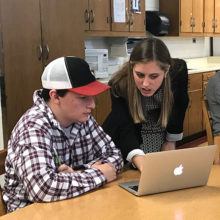This summer, thousands of teenagers across North Carolina are excitedly — and nervously — preparing for the big move to college. Many, however, will not set foot on a college campus this fall despite every intention of doing so at graduation.
The transition from high school to college is one of the biggest leaks in the educational pipeline from elementary school to degree attainment.
As highlighted in the myFutureNC policy brief, “The Transition from High School to College in North Carolina,” among every 100 9th grade students in North Carolina, 86 graduate from high school, and only 57 enroll in postsecondary education within 16 months of graduation. Even fewer obtain a degree or industry-validated credential.
This policy brief explores the data on transitions from high school to college in North Carolina and examines different approaches to support students in this transition. Here are a few key findings, and you can find the full brief below.
How is North Carolina doing?
More North Carolinians are graduating from high school but only half are college and career ready
North Carolina’s graduate rate has increased from 74.2 percent in 2010 to 86.5 percent in 2017, but only 50 percent of students tested at college and career readiness levels on end-of-course exams in 2017. There are large gaps in readiness: 63 percent of white students tested college and career ready compared to 30 percent of black students and 39 percent of Hispanic students.
NC college graduates have lower levels of debt but many fail to fill out the FAFSA
While 58 percent of North Carolina’s four-year college graduates leave school with debt, the average debt is the ninth-lowest in the country at $25,562. However, many North Carolinians are leaving money on the table. In 2017, fewer than 60 percent of students in 52 out of 115 school districts filled out the Federal Application for Financial Student Aid (FAFSA).
After the recession, enrollment flat at UNC system and declining at community colleges
Postsecondary institutions tend to experience greater enrollment during recessions as students who can not find jobs enroll in school. Since 2010, the number of curriculum students enrolled in North Carolina’s community colleges has decreased from 338,431 to 295,639. Both applications and acceptances to UNC system colleges have actually increased since 2010, although enrollment of North Carolina high school graduates has declined slightly.
How can North Carolina minimize the leaks?
An incremental approach
The brief author, Julie Edmunds, proposes the following steps North Carolina could take within the existing systems:
- Engage middle and high school students in college and career planning
- Require students to develop a post-high school plan
- More funding for counselors so students receive support and assistance in planning process
- School districts establish partnerships with postsecondary institutions and businesses to provide counseling and work-based learning
- Align content and skills
- Pair high schools with postsecondary institutions to align curriculum content and ensure high school teachers understand college courses
- Test effectiveness of North Carolina law requiring schools to test students for college readiness and provide remedial coursework
- If found successful, expand this approach
- Embed advanced course enrollment in the high school accountability system
- Add a measure of the proportion of students taking college-level courses to the high school accountability measure
- Increase counselors or support for a college-liaison in high schools
- Incorporate reminders and “nudges” into admissions systems
- Provide funding for customized reminders to students during the application process
- Improve alignment across postsecondary institutions
- Examine alignment between AP credits and major prerequisites across the UNC system
- Connect financial aid to more comprehensive support programs
- Revisit financial aid programs to incorporate programs and strategies that increase persistence and success in college
A radical re-envisioning of the current system
Edmunds also examines how a radical restructuring of the current system to reflect the continuum of education could address the leaky pipeline:
“What if we considered high school and college as part of a continuum of education, not necessarily two separate systems?”
In this system, students would be able to take high school and college courses concurrently. In four to five years, they would be able to attain both a high school diploma and either a technical credential, an associate degree, or two years of transferable college credit.
Edmunds surfaces some concerns with this approach, including providing adequate funding to high schools, determining core classes for all high schoolers, expanding capacity of postsecondary institutions to provide more college courses, ensuring schools have the necessary technology, and increasing the number of counselors to guide students through this process.


